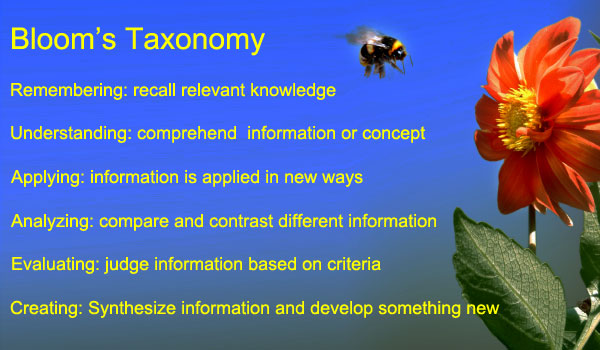Bloom's Taxonomy
One of our main goals as teachers is to focus on our students' understanding of the concepts that we teach. We are good at helping students to recall what we have taught them and using this to teach them to understand and apply new information. The academic standards and the State exams are focused on what students know, understand, and are able to do. These are the lower-level thinking skills that all students must acquire in order to be academically successful. Aligning with the standards will fulfill students' needs for academic engagement. Aligning to student interests and providing students with the ability to use their higher-order thinking skills will intellectually engage them.
At what level are your students learning? Bloom's Taxonomy is a classification of thinking which was first introduced in 1956 by Benjamin Bloom. This taxonomy is broken into six hierarchical levels. The lowest levels include remembering, understanding, and applying and the highest levels include analyzing, evaluating, and creating.

When we talk about lower- and higher-order of thinking we are referring to these levels. Lower-order thinking is not a derogatory term. It is essential to learning and thinking. Bloom's Taxonomy is often illustrated as a series of steps with remembering being the first step. A student must master one level or step before moving onto the next. When planning instruction you should determine the level of learning you wish your students to attain.
One of Pennsylvania's Great Educators, Benjamin Bloom (1913-1999), was born in Lansford, Pennsylvania.
Bloom introduced his taxonomy of thinking in 1956 through the publication The Taxonomy of Educational Objectives, The Classification of Educational Goals, Handbook I: Cognitive Domain. Since that time Bloom's Taxonomy has been revised and expanded many times. The current version is represented here.
Lower-Order Thinking:
- Remembering: student recalls or remembers relevant information.
- Understanding: student is able to explain information or concept.
- Applying: student can implement information and use it in new ways.
Higher-Order Thinking
- Analyzing: student can break information into parts, organize the parts, and determine how they relate.
- Evaluating: student can critique information and make informed judgments.
- Creating: student can put together a variety of elements or reorganize elements to create or develop something new.
Although not everything you teach must engage higher-order thinking, the more opportunities you provide to students that engage their critical thinking skills, the more meaningful the concepts and competencies will become to them. A student who has analyzed, evaluated, or created something with a concept is more likely to be able to demonstrate the competencies when he or she is formally assessed.
